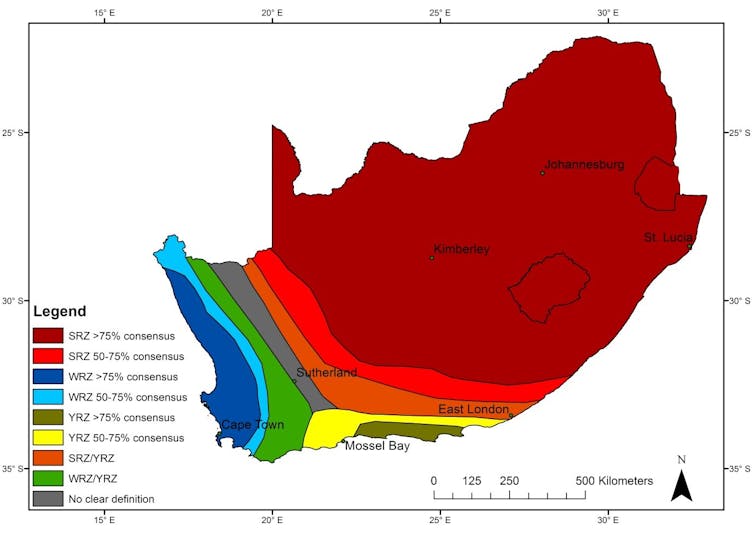Scientists split on South Africa’s winter and summer rainfall zones
- Jennifer Fitchett, Chris Curtis and Sarah Roffe
South Africa is among a handful of countries that experience winter rainfall in some areas and summer rainfall in others.
The southwestern tip of the country has a Mediterranean climate, with hot dry summers and cool wet winters. This is because mid-latitude cyclones migrate further north during winter, allowing the edge of the cold front arm to sweep across the southern most part of the country.
The interior is dry and cold in winter, with subsiding air from strong high pressure systems. In summer this high pressure moves south, causing the dry conditions in the Western Cape and allowing convective storms in the interior.
All this is well documented. What is unclear is where exactly the boundary between the winter and summer rainfall zones exists. There is consensus that Cape Town is in the winter rainfall zone, and Johannesburg is in the summer rainfall zone, but these cities are separated by a 1,400km distance. What about the zone in between?
As it turns out, not even climate scientists are sure. We discovered this in research we did to try and pin down where the line might be drawn. We geo-referenced all the existing rainfall seasonality maps, using Geographic Information System software to determine the areas of overlap between the maps. We found that there was no agreement in the position of this line. This is a problem for farmers, tourists, and even high school geography students who need to accurately classify the rainfall seasonality of a particular town.
Interrogating historical maps
We explored 60 South African rainfall seasonality maps that published between 1938 to present. Although some of these maps are direct republishing of an original map, each unique map has used a different climatological or statistical approach, and each has a slightly different location of the boundary of the winter rainfall zone.
A large area of the country has an agreement in rainfall zone classification of 75% or more. However, the region between the winter and summer rainfall zones is highly contested. A large band is classified by half of the scientists as winter rainfall zone, and half as summer rainfall zone. A smaller area, including the town of Sutherland, is completely disputed with researchers classifying it as summer, winter and year-round rainfall zones.

This problem is largely unique to South Africa. Much of the Mediterranean, which experiences a similar climatic transition, comprises small countries and thus each has a relatively coherent rainfall regime. Other countries that have changes in rainfall zone have a density of rainfall stations which means they don’t face the same problem. That said, this is one of the first papers to explore disagreements in rainfall zone mapping.
To complicate matters, boundaries appear to be shifting under climate change. In South Africa the winter rainfall zone extended as far north as Lesotho and the Free State during the Last Glacial Maximum, 24,000 years ago. It has progressively migrated south over the past 20,000 years.
Recent research suggests that a continued southward migration under climate change may have been responsible for the severe 2015-2017 drought in Cape Town. This southward migration in the westerlies (winds blowing from the west toward the east) has been reported for the entire southern hemisphere. Similar impacts of a weakened westerly system has also been implicated in the California drought of 2013-2014.
Why it matters
The classification of rainfall seasonality is important beyond academic debate. Tourism marketing relies heavily on providing potential visitors with an accurate picture of the weather that they can expect so that they can choose their destination to visit, plan the timing of their vacation and pack appropriate clothing.
Agriculture also relies on accurate and well documented climate information allowing farmers to sow their crops at the correct time of the year, select appropriate crops for the area, and manage pest and plant invasions effectively.
Even sectors such as transport and shipping and manufacturing benefit from accurate climate information. Pilots, for example, need accurate climate information to determine flight paths.
Better measures needed
Our study highlights that there needs to be a more systematic approach to classifying rainfall seasonality in South Africa. The country needs to decide on the most appropriate measure of seasonality, and apply it to all of the available rainfall stations in the country. Farmers, tourists and climatologists will all need to keep a particularly close eye on these shifting zones over the next few years.![]()
Jennifer Fitchett, Senior Lecturer in Physical Geography, University of the Witwatersrand; Chris Curtis, Professor of Geography, University of the Witwatersrand, and Sarah Roffe, PhD student, Climatology , University of the Witwatersrand. This article is republished from The Conversation under a Creative Commons license. Read the original article.

